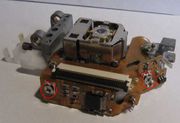CD and DVD players: Difference between revisions
(Created page with "This page covers CD, DVD and Blue-ray players. ==Summary== An optical disk (CD, DVD or Blue-ray, and all the variants) contains a spiral track of minute pits or spots of diff...") |
m (→Diagnosis) |
||
| Line 5: | Line 5: | ||
==Diagnosis== | ==Diagnosis== | ||
[[File:Img_2054a.jpg|180px|thumb|right|A laser head from a CD/DVD drive.]] | [[File:Img_2054a.jpg|180px|thumb|right|A laser head from a CD/DVD drive. Two laser power adjustment controls are shown ringed in red.]] | ||
A visual inspection should first be undertaken. Look for dust, hairs or fluff on the lens, but never touch it with your fingers. | A visual inspection should first be undertaken. Look for dust, hairs or fluff on the lens, but never touch it with your fingers. | ||
Revision as of 11:52, 19 February 2015
This page covers CD, DVD and Blue-ray players.
Summary
An optical disk (CD, DVD or Blue-ray, and all the variants) contains a spiral track of minute pits or spots of different reflectivity. Unlike a vinyl LP, the track starts in the middle. In the case of a normal CD, the spiral if unwound would be 5.7km in length. The spots are only of the order of 1/1000mm wide, and the laser has to follow them precisely. It's hardly surprising therefore that players not infrequently fail.
Diagnosis
A visual inspection should first be undertaken. Look for dust, hairs or fluff on the lens, but never touch it with your fingers.
The lens is typically suspended on 4 thin springy wires, allowing it to be moved up and down to focus or sideways to follow the track. Several coils attached to the lens move it relative to fixed permanent magnets.
Using a small screwdriver or similar tool, very gently prod the lens to see if it moves freely, but don't move it more than a fraction of a millimetre. Check for any signs that any of the springy wires are broken or distorted. In such a case, a repair is unfortunately not normally practical.
There is usually an interlock which prevents the disk from spinning while the lid is open, which you may be able to override by pressing it with a suitable tool. You may need to partially disassemble the unit to do so.
The following should not be tried on mains powered equipment with the lid off unless you are completely sure you can do so safely. If you can override the interlock whilst turning the player on with no disk inserted, you should see the spindle start to rotate, then the lens move to a position close to the spindle. You may then see the laser come on and the lens jiggle up and down as it tries to focus on the disk. CD-only players may use an infrared laser which you won't be able to see come on, though a digital camera or camera phone may.
The previous test will show whether there are any major mechanical problems.
Repair
Safety
References
External links
- External links as bullet points
